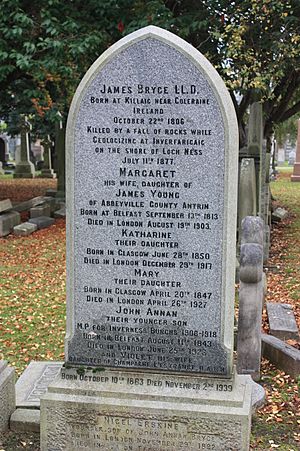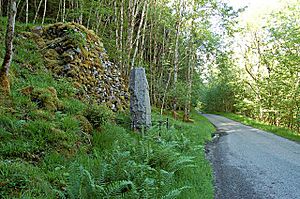James Bryce (geologist) facts for kids
James Bryce (born October 22, 1806, died July 11, 1877) was an amazing Irish scientist. He was a mathematician, a naturalist (someone who studies nature), and a geologist (someone who studies rocks and the Earth). He loved exploring and learning about the natural world around him.
Contents
A Life of Learning and Exploration
James Bryce was born in Killaig, near Coleraine, Ireland. He was the third son in his family. He learned a lot from his father and older brother. Later, he went to the University of Glasgow and did very well in his studies, especially in classical subjects.
Becoming a Teacher
In 1826, James Bryce became a teacher at the Belfast Academical Institution. He taught math and business subjects. He was also the secretary for the Belfast Natural History Society from when it first started.
He had planned to become a lawyer. However, he decided to become a teacher instead. He became a math teacher at the Belfast Academy, which was a very respected school. In 1836, he married Margaret Young. In 1840, he moved to Glasgow to teach at the High School of Glasgow. He worked there until he retired in 1874.
James Bryce was a brilliant teacher of both math and geography. But his biggest passion was studying natural history.
Discovering Geology
He spent a lot of time researching geology. First, he explored northern Ireland, and then Scotland and northern England. In 1834, he started writing articles about fossils found in Antrim. Important geologists like Sir Roderick Murchison and Sir Charles Lyell noticed his work.
He became a member of the Geological Society of London and the Geological Society of Dublin. His most important papers were about the Giant's Causeway. He was the first to fully study and describe its amazing structure. He also wrote books on algebra, astronomy, geography, and the geology of the islands around the Clyde River.
James Bryce strongly believed that schools should teach more about natural history and science. He even volunteered to teach these subjects himself, as they weren't usually part of the school curriculum back then.
Later Life and Legacy
In 1868, the University of Glasgow gave him an honorary degree (LL.D.). He had helped a lot with changes and improvements at the university. After retiring from Glasgow, he moved to Edinburgh. He continued to publish his geological findings in the 'Transactions of the Royal Society of Edinburgh.'
He was a very careful and accurate observer. He loved nature and was very active. He kept exploring the Scottish Highlands with great enthusiasm until the end of his life.
Sadly, James Bryce died on July 11, 1877. He was examining a unique rock formation at Inverfarigaig, near Loch Ness. Some loose stones fell on him, causing his death instantly.
He is buried in the Grange Cemetery in Edinburgh. His wife, Margaret, and his son, John Annan Bryce, are buried with him. John Annan Bryce later became a Member of Parliament for Inverness.
Published Works
Here are some of the books and papers James Bryce wrote:
- 1831 Tables of simple minerals, rocks, and shells
- 1834 An account of the celebrated Portrush rock
- 1837 A treatise on the elements of algebra
- 1837 On the geological structure of the north-eastern part of the county of Antrim
- 1848 First principles of geography and astronomy
- 1852 Geological notices of the environs of Belfast, the east coast of Antrim, and the Giant's Causeway
- 1870? The International Atlas and Geography: Modern, Historical, Classical and Physical



